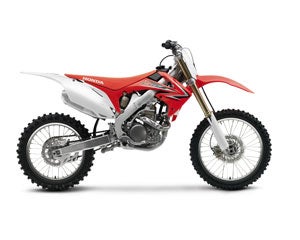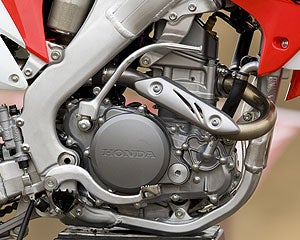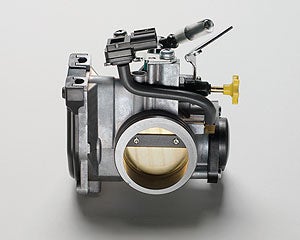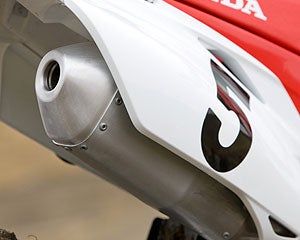2010 Honda CRF250R Motorcycle
Design integration reaches new heights
 It’s good to be the king. It’s even better to stay the king. And that’s why the class-leading CRF250R is all new from the dirt up for 2010, with an all-new Programmed Fuel Injection system, more compact Unicam® engine, new-generation frame, plus our Honda Progressive Steering Damper, and so much more. Once again, the best just keeps getting better.
It’s good to be the king. It’s even better to stay the king. And that’s why the class-leading CRF250R is all new from the dirt up for 2010, with an all-new Programmed Fuel Injection system, more compact Unicam® engine, new-generation frame, plus our Honda Progressive Steering Damper, and so much more. Once again, the best just keeps getting better.
What’s new at a glance
- All-new, more-compact Unicam four-valve engine.
- Programmed Fuel Injection (PGM-FI) with 50mm throttle body improves engine response, fuel economy and increases horsepower.
- New higher-capacity airbox, designed for enhanced breathing, increased power and easier access.
- All-new single muffler exhaust system lowers weight and improves mass centralization.
- All-new chassis with Progressive Steering Damper (HPSD)-equipped twin-spar frame, forged-aluminum steering head, stronger downtubes and simplified removable rear subframe
- All-new Showa front and rear suspension with upper and lower fork tubes and shock developed exclusively for the CRF250R.
- Brake system includes integrated rear master-cylinder/reservoir, link-type front brake master cylinder.
- New bodywork and ergonomics improve comfort and handling feel.
The CRF250R engine: It all flows from here
 Not long ago engine design revolved almost exclusively around power production, and it was up to the chassis designers to figure out how to package it. But the 249cc Unicam engine in the 2010 CRF250R illustrates exactly how far engine design has progressed, as every aspect of the bike is now interlinked so everything from chassis geometry to center of gravity affects engine design.
Not long ago engine design revolved almost exclusively around power production, and it was up to the chassis designers to figure out how to package it. But the 249cc Unicam engine in the 2010 CRF250R illustrates exactly how far engine design has progressed, as every aspect of the bike is now interlinked so everything from chassis geometry to center of gravity affects engine design.
So the new CRF250R engine became as compact as possible while improving its already outstanding durability, power production and broad powerband. Honda’s Unicam design itself plays a major role in this effort. Using a hybrid combination of directly actuated titanium intake valves and forked-rocker-arm operated steel exhaust valves, Unicam design allows the camshaft to mount lower in the head, thereby providing a far more compact cylinder head than a conventional DOHC design. For 2010, Honda engineers shortened the CRF250R cylinder head significantly by eliminating the separate camshaft blocks and machining the camshaft bearing surfaces directly in the head. Overall engine height also dropped as a result of a new forged slipper piston with a thinner crown.
Redesigning the CRF250R’s lubrication system also helped shorten engine height. The system utilizes a reed valve for crankcase breathing, and engineers redesigned the system to position the valve horizontally rather than in the previous vertical position. This allowed the CRF250R’s crankshaft to be positioned 10mm lower, further lowering the bike’s center of gravity.
Because of the new engine design, the 2010 CRF250R is able to use a single muffler that is both lighter and more compact than the dual system used in ’09. The repackable muffler saves a total of 350 grams in overall weight and sits 50mm further forward, improving mass centralization and lowering the bike’s center of gravity for quicker handling and lighter steering.
strength material to achieve higher rpm, netting stronger mid- to high-rpm power. These valve springs operate a pair of 30.5mm titanium intake valves, paired with 25mm steel exhausts. A low-friction piston treatment helps permit higher engine speeds as well—up to 13,500 rpm. New gearing across the board in the close-ratio five-speed gearbox takes full advantage of this new rpm ceiling, while straighter intake ports and a slight increase in compression (13.2 vs. 13.0 last year) contribute to the CRF250R’s outstanding overall power and easy starting.
PGM-FI: Fuel injection comes to the 250 class
 For 2010 the CRF250R features Honda’s Programmed Fuel Injection system, which combines all the benefits of fuel injection—precise fuel delivery, excellent efficiency, outstanding throttle response and across-the-board power—in an incredibly light and compact package. The CRF250R utilizes a 50mm throttle body with a 12-hole injection nozzle for precise fuel metering, and a lightweight 50-psi pump to ensure optimum fuel delivery and a precisely targeted fuel charge. The system significantly improves partial-throttle response to ensure excellent rideability. Whether it’s a race-opening holeshot or instant drive from a third-gear corner, the CRF250R adapts to riding conditions as quickly as the rider can roll on the throttle.
For 2010 the CRF250R features Honda’s Programmed Fuel Injection system, which combines all the benefits of fuel injection—precise fuel delivery, excellent efficiency, outstanding throttle response and across-the-board power—in an incredibly light and compact package. The CRF250R utilizes a 50mm throttle body with a 12-hole injection nozzle for precise fuel metering, and a lightweight 50-psi pump to ensure optimum fuel delivery and a precisely targeted fuel charge. The system significantly improves partial-throttle response to ensure excellent rideability. Whether it’s a race-opening holeshot or instant drive from a third-gear corner, the CRF250R adapts to riding conditions as quickly as the rider can roll on the throttle.
A redesigned auto decompression system features shaft-integrated components to provide easy starting in hot or cold conditions. The combination of ultra-precise PGM-FI, the revised decompression system and a kick-start mechanism with altered gearing make the CRF250R one of the easiest starting Honda motocrossers in history.
Feeding the new fuel-injection system is a large-volume air filtration system. The new frame, seat and side-panel design mean filter maintenance is greatly simplified compared to the ’09 model. The improved fuel economy provided by the PGM-FI system means the new CRF250R can make it through a full moto with a smaller fuel load—1.5 gallons compared to 1.9 in ‘09—which not only means a lighter bike overall but one with less change in handling dynamics as fuel load decreases, along with a more open riding environment for the pilot.
Finally, the new PGM-FI provides easily accessed tuning connectors behind the radiator shroud, which simplify tuning the new system via the optional HRC PGM-FI Setting Tool. The Honda Genuine Accessory Setting Tool allows CRF250R owners to alter EFI fuel delivery as well as ignition timing over a wide range of settings to alter engine power characteristics to suit rider preference or track conditions. The engine-stop switch also provides an onboard diagnostic test, with a pre-ride check indicator.
American Honda will also be offering a lineup of Honda Genuine Accessories developed by HRC® for the 2010 CRF250R. The HRC-branded line will include both functional and cosmetic accessories.
The CRF250R chassis: Tying it all together
Compared with the ’09 frame, the new CRF250R’s Twin-Spar unit features reduced spar width (from 27mm to 26mm) and height (from 70mm to 66mm), both of which shave nearly a pound off the new frame. The lower engine frame rails are wider and are now beveled to provide added cornering clearance. A new swingarm shaves further grams by reducing the cross-member wall thickness compared to the ’09 CRF250R. This new swingarm bolts to forged-aluminum pivot plates that provide increased rigidity and improved handling. Above those, the removable rear subframe was redesigned to eliminate the extra weight of brackets and cross-members, and was also reshaped to improve air filter access, lower the seat height and narrow the bike’s profile.
weight of brackets and cross-members, and was also reshaped to improve air filter access, lower the seat height and narrow the bike’s profile.
New frame geometry places the front wheel 15mm closer to the crankshaft for improved steering response, further enhanced by a 2mm reduction in triple-clamp offset (from 22mm to 20mm). Rake has also changed from 27˚ 50’ to a more aggressive 27˚ 15’. A 0.6-inch longer wheelbase and lower center of gravity improve drive out of corners.
The CRF250R also gets a new Pro-Link shock linkage this year and new Showa suspension front and rear, both with fully adjustable compression and rebound damping. Lighter than last year’s shock, the new rear damper uses a large-diameter (50mm) piston and an integrated more compact reservoir—once again improving mass centralization. With longer travel than last year’s 250, the new shock provides 12.6 inches of wheel travel (12.4 in ’09) with softer initial response and improved mid-stroke control. The new Showa shock offers adjustable preload and 17-way adjustable rebound damping; compression damping includes both low-speed (13 clicks) and high-speed (3.5-turns) adjustments.
Showa’s 48mm inverted fork (up from 47mm in ’09) also improves initial action and mid-stroke feel. Adjustments include 16-position rebound and compression damping adjustments to adapt its 12.4-inches of travel to specific track demands. The exclusive Honda Progressive Steering Damper (HPSD) mounts to the lower triple clamp for excellent steering feel and positive straight-line handling. While it allows even more aggressive steering angles for improved cornering, the damping action increases with steering input, providing smooth feel and natural steering characteristics.
The 2010 CRF250R incorporates lightweight 240mm brake rotors front and rear, plus a top-quality aluminum Renthal handlebar (971 bend) with two alternative rubber-mounted positions for improved comfort and reduced fatigue. Optimized rider ergonomics adapt the handlebar, seat and footpeg height to place the rider’s legs at the narrowest part of the frame, improving both comfort and handling feel. A lower fuel cap allows the rider to slide up farther on the tank, while narrower radiator shrouds make it even easier to do so. The reshaped seat lowers the seat height yet maintains the same seat-foam thickness.
The devil is in the details
The CRF250R reflects the kind of attention to detail racers have come to expect from Honda, with a myriad of seemingly minor changes that can ultimately make a major difference. For example, the 25mm rear axle features reduced wall thickness (2.5mm to 2.2mm), saving 38 grams of critical unsprung weight. The axle slides through large-diameter bearings and a strengthened axle collar that increase rigidity. Even the kickstart lever was reshaped to shave a few grams.
 Other such details abound on the CRF250R, increasing durability, ease of ownership or simplified maintenance. For instance, the rear fender’s shape helps prevent mud and debris from gathering on the muffler. A built-in fuel-tank tether eliminates the need to disconnect the fuel line while working on the engine top-end. The rear subframe allows easy access to the washable dual-foam air filter, and the repackable muffler ensures consistent power and noise-control throughout the bike’s life. Top quality Dunlop 80/100-21 742FA front and 100/90-19 D756 rear tires help make the CRF250R ready to race, right off the showroom floor.
Other such details abound on the CRF250R, increasing durability, ease of ownership or simplified maintenance. For instance, the rear fender’s shape helps prevent mud and debris from gathering on the muffler. A built-in fuel-tank tether eliminates the need to disconnect the fuel line while working on the engine top-end. The rear subframe allows easy access to the washable dual-foam air filter, and the repackable muffler ensures consistent power and noise-control throughout the bike’s life. Top quality Dunlop 80/100-21 742FA front and 100/90-19 D756 rear tires help make the CRF250R ready to race, right off the showroom floor.
In addition to all the improvements for power, strength, durability and convenience, the 2010 CRF250R weighs in a full pound less than its predecessor—226 pounds, fully gassed and ready for the starting gate.
the lower triple clamp for excellent steering feel and positive straight-line handling. While it allows even more aggressive steering angles for improved cornering, the damping action increases with steering input, providing smooth feel and natural steering characteristics.
The 2010 CRF250R incorporates lightweight 240mm brake rotors front and rear, plus a top-quality aluminum Renthal handlebar (971 bend) with two alternative rubber-mounted positions for improved comfort and reduced fatigue. Optimized rider ergonomics adapt the handlebar, seat and footpeg height to place the rider’s legs at the narrowest part of the frame, improving both comfort and handling feel. A lower fuel cap allows the rider to slide up farther on the tank, while narrower radiator shrouds make it even easier to do so. The reshaped seat lowers the seat height yet maintains the same seat-foam thickness.


 Your Privacy Choices
Your Privacy Choices